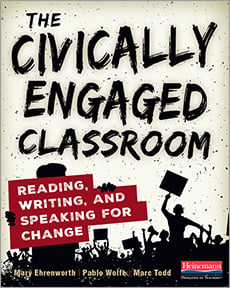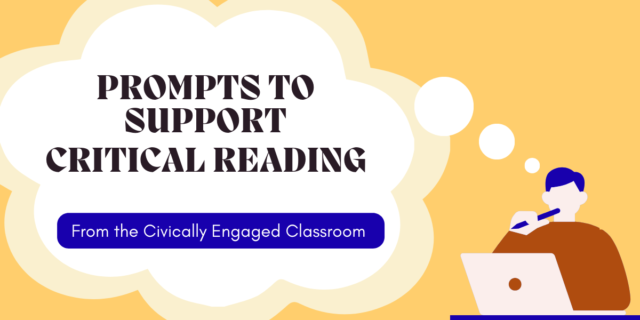
The following is excerpted from The Civically Engaged Classroom.
We exist at the intersection of many cultures and groups and it is their interplay that helps us define our loves, our passions, where we find beauty, and how we express happiness. These cultures, however, also inform the biases that we have about those who exist outside of our cultures: we and our students are all conduits of those biases and suffer from them in unequal measures. As Ibram X. Kendi notes in Stamped from the Beginning (2016), we are all inadvertently racist—and classist and sexist and homophobic—because the very air we breathe is infused with historical and current racism. We are embedded in a society in which oppression around race, gender, class, and sexual orientation is endemic.
The goal of this work is not that students (or teachers) divulge or confess biases publicly, but that they become aware of and interrupt the biases at work inside their own heads. Our minds create stereotypes as mental shortcuts in order to make quick judgments and navigate through life without being overwhelmed. However, these shortcuts need to be interrogated regularly so that we do not sacrifice the individual identity of the person in front of us to the generalizations our life experiences have fed us. Yet even doing this work internally asks students to be extraordinarily vulnerable. You might consider smaller groupings as kids try out this work. Partnerships, especially choice partnerships, where students are able to work with someone they are comfortable with, are more intimate and safer than larger groups or ones the teacher chooses.
Model Interrogating Your Own Biases
When we are the first to say, “Oh, my gosh, my response to that was racist,” or “Thank you for pointing out that that was racist,” (not, “could be perceived as racist,” and not “hurtful,”), we model an openness to interrogating our own biases. This is especially important for white educators to bear in mind. In White Fragility, Robin DiAngelo says, “One of the greatest social fears for a white person is being told that something that we have said or done is racially problematic. Yet when someone lets us know that we have just done such a thing, rather than respond with gratitude and relief (after all, now that we are informed, we won’t do it again), we often respond with anger and denial” (2018, 4). She goes on to say that “racism is unavoidable and that it is impossible to completely escape having developed problematic racial assumptions and behaviors.” Mary can attest to many uncomfortable moments. We are so thankful for colleagues who care enough about us to address our language.
With your own admissions, help students understand that everyone has biases and that those who reflect and acknowledge their natural biases are best suited to combat them. This is a difficult concept for anyone—adult or adolescent—to accept; you’ll want to carefully consider the types of activities you use and the partnership structures you put in place so that students will feel safe enough to truly reflect. They are going to be uncomfortable. That’s inevitable and part of the process of awareness. Social bonds that students trust will help them move through stages of discomfort to learning. We recommend that students use notebooks as they self-assess and that they fold down pages if they want their writing to remain private. Respecting students’ privacy and the emotional labor they may be involved in or protecting themselves from is important.
Media Lessons in Implicit Bias
If you have access to laptops in your classroom, you might want to begin by setting up stations devoted to implicit bias. You could have some students study the New York Times video “Peanut Butter, Jelly and Racism” (Reshamwala 2016) and then jot some notes on the meaning of implicit bias. Another group may explore gender bias by watching “Like a Girl” (Always 2020) and unpacking their reaction to the video. You might have one or two groups explore MTV’s “Look Different” site, which has several quizzes, activities, and articles to help students identify their own biases. If you decide to include the implicit bias tests on this site, you may want to invite students’ participation to be voluntary. If students do use the tests, you’ll want to clarify that the tests are not meant to label individuals as biased or racist. On the contrary, they are tools to help us name the implicit—and explicit—biases we have so that we can consciously combat them. The less aware we are of our biases, the more power those biases have over us. You’ll want to assure your students that the discomfort they may feel is shared and that it is important to confront and question it rather than allow it to linger.
The objective of engaging with any of these sites is to give students opportunities to self-reflect. A prompt like this one can get that process started:
- We’ve discussed how all of us have our biases and that the first way to combat them is to be aware of them. At this station you’ll be watching: __________. After you’ve watched the video, respond to it in your notebook. As you respond, you may use the following self-reflection questions and prompts to spur your thinking.
- Remember, your notebook is for your reflection only. You do not need to share what you write. If you’d like to keep these pages private, just fold down the corner.
- What are your initial reactions to the video? Why?
- Name three things you learned from the video, two questions you still have, and one new realization about yourself that you’re developing.
- Was there anything that made you uncomfortable while you were watching the video? Explain.
This work on identity and implicit bias is really only an introduction. Our aim in this work is to prepare your students to read the content that lies ahead of them with an understanding that their own identity and bias may have a role in how they interpret what they are learning.



